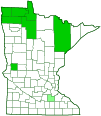Elk
(Cervus canadensis)
Conservation • Description • Habitat • Ecology • Distribution • Taxonomy
Conservation Status |
|
|||
| IUCN Red List | LC - Least Concern |
|||
| NatureServe | N5 - Secure S3 - Vulnerable |
|||
| Minnesota | Special Concern Species in Greatest Conservation Need |
|||
Description
Size
Total length: 5¾′ to 8¾′
Mass: 147 lb to 110 lb
Sign
Similar Species
Habitat
Open brushlands and grasslands with nearby woodlands or forested areas
Ecology
Behavior
Lifespan
20 years or more
Life Cycle
Food
Distribution |
||
|
Sources Biodiversity occurrence data published by: Minnesota Biodiversity Atlas (accessed through the Minnesota Biodiversity Atlas Portal, bellatlas.umn.edu, 12/12/2025). Timm, R. M. 1975. Distribution, natural history, and parasites of mammals of Cook County, Minnesota. Occasional Papers, Bell Museum of Natural History, University of Minnesota 14:1–56. Hazard, Evan B. 1982. The Mammals of Minnesota. University of Minnesota Press, Minneapolis, Minnesota. 280 pp. The counties in light green lack modern records but have historic county or township specimens or records. The observation in Rice County is an Elk shot in Whitewater Wildlife Management Area on 11/8/2020. The identification was confirmed by a Minnesota DNR Conservation Officer. It was probably an escapee form a nearby game farm. |
|
| 12/12/2025 | ||
Occurrence |
||
Rare in Minnesota |
||
Taxonomy
Class
Subclass
Theria
Infraclass
Placentalia (Placental Mammals)
Magnorder
Boreoeutheria
Superorder
Laurasiatheria (Ungulates, Carnivorans, and Allies)
Order
Artiodactyla (Even-toed Ungulates and Cetaceans)
Suborder
Ruminantia (Ruminants)
Infraorder
Pecora
Superfamily
Cervoidea
Family
Cervidae (Deer)
Subfamily
Cervinae (Old World Deer)
Tribe
Cervini (Traditional Old World Deer and Elk)
Genus
Cervus (Typical Old World Deer and Elk)
Subgenus
Cervus
Species
Elk was formerly named Cervus elaphus canadensis, one of numerous subspecies of Red Deer (Cervus elaphus). A mitochondrial study published in 2004 indicated that it should be recognized as a separate species.
Subordinate Taxa
Under the new classification, there is disagreement about the number of subspecies. Fourteen subspecies of C. canadensis have been described. Recent DNA studies suggest that there are only three or four subspecies, that all North American elk belong to the subspecies C. c. canadensis, and that regional differences are local adaptations and should be considered ecotypes or races.
Minnesota lies within the historical range of Eastern Elk (C. c canadensis) and Manitoban elk (C. c. manitobensis). The former is now extinct and the latter is extirpated due to hunting and the gradual disappearance of suitable habitat. Rocky Mountain Elk (C. c. nelsoni) have been widely transplanted in the United States. Today, most elk in North America, including Minnesota’s two populations, are Rocky Mountain Elk.
Northern and American group
Altai Wapiti (Cervus canadensis sibiricus)
Eastern Elk (Cervus canadensis canadensis) extinct
Manitoban Elk (Cervus canadensis manitobensis)
Merriam’s Elk (Cervus canadensis merriami) extinct
Rocky Mountain Elk (Cervus canadensis nelsoni) ![]()
Roosevelt Elk (Cervus canadensis roosevelti)
Tian Shan Wapiti (Cervus canadensis songaricus)
Tule Elk (Cervus canadensis nannodes)
Eastern group
Alashan Wapiti (Cervus canadensis alashanicus)
Manchurian Wapiti (Cervus canadensis xanthopygus)
Southern group (Central Asian red deer)
Kansu Red Deer (Cervus canadensis kansuensis)
Kashmir Stag (Cervus canadensis hanglu)
MacNeill’s Deer (Cervus canadensis macneilli)
Tibetan Red Deer (Cervus canadensis wallichii)
Synonyms
Cervus elaphus canadensis
Common Names
Elk
Red Deer
Wapiti
Visitor Photos
Share your photo of this mammal.
This button not working for you?
Simply email us at info@MinnesotaSeasons.com.
Attach one or more photos and, if you like, a caption.
|
|
|
MinnesotaSeasons.com Photos
|

Slideshows
Cervus elaphus (American Elk)
Allen Chartier
Rocky Mountain Elk
Dan Dzurisin
Elk
Diane Higdem Photography

Visitor Videos
Share your video of this mammal.
This button not working for you?
Simply email us at info@MinnesotaSeasons.com.
Attach a video, a YouTube link, or a cloud storage link.
Other Videos
Elk vs. Photographer | Great Smoky Mountains National Park
Vince M. Camiolo
Rocky Mountain Elk (Cervus canadensis nelsoni) Bugle
jdeuce13
Answer the Call -- Rocky Mountain Elk Foundation
Rocky Mountain Elk Foundation
Elk In America (Trailer)
Janson Media
Listen: These Elk Sound Terrifying, Like Ringwraiths | National Geographic
National Geographic

Visitor Sightings
Report a sighting of this mammal.
This button not working for you?
Simply email us at info@MinnesotaSeasons.com.
Be sure to include a location.
Minnesota Seasons Sightings





